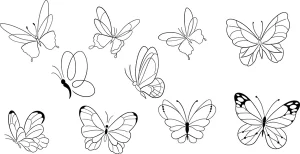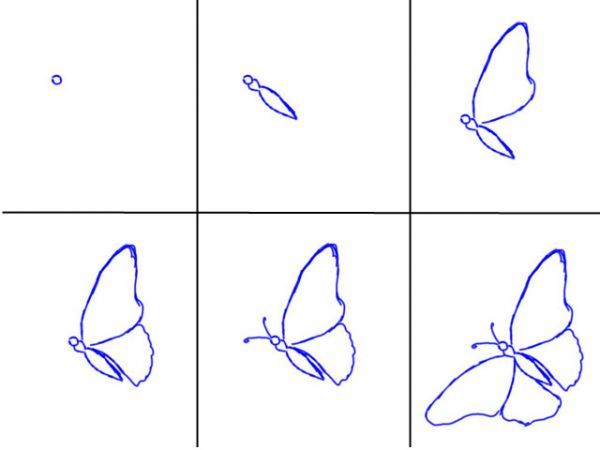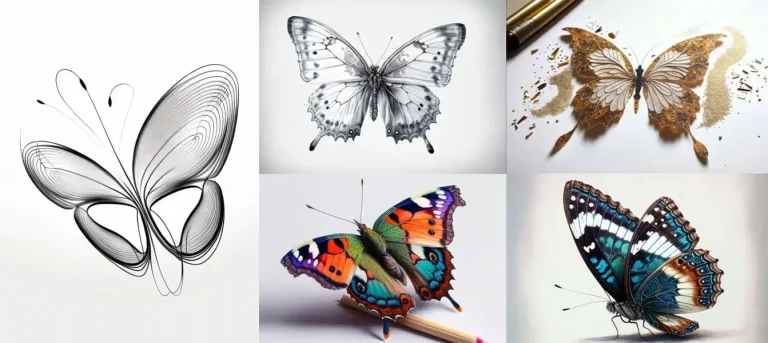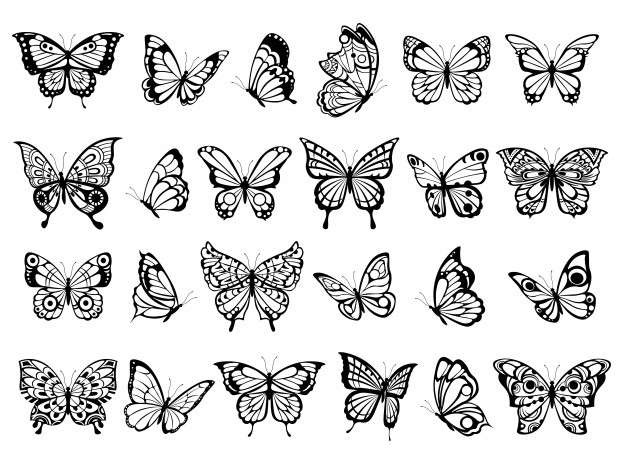A butterfly drawing is a visual representation of this beautiful winged insect, captured on paper or any other two-dimensional surface. It can take many forms, from realistic to abstract, simple to intricate, depending on the artist’s vision and skill. Ultimately, a butterfly drawing is a way for the artist to share their appreciation for these captivating creatures and their vibrant world. It can be a beautiful and expressive art form, capturing the essence of flight, metamorphosis, and the sheer wonder of nature.

Basics of Butterfly Drawing
The basic anatomy of a butterfly is quite simple, making them a great subject for beginner artists. Here’s a step-by-step guide to drawing a butterfly:
- Start with the body. Draw an oval for the thorax (middle section) and a smaller circle for the head
- Add the wings. Draw two large teardrop shapes for the upper wings and two smaller teardrops for the lower wings. Make sure the wings are symmetrical on both sides.
- Refine the wings. Add a curved line in the middle of each wing to separate the forewing and hindwing. Then, draw a few more lines to suggest the veins in the wings.
- Draw the details. Add small circles for the eyes and two thin lines for the antennae. You can also add some stripes or other patterns to the body and wings.
- Color your butterfly. Get creative! Butterflies come in all sorts of colors and patterns, so use your imagination to make your butterfly unique.
Here are some additional tips for drawing butterflies:
- Use light pencil strokes at first so you can easily erase any mistakes.
- Pay attention to the symmetry of the wings.
- Don’t be afraid to experiment with different colors and patterns.
- There are many different types of butterflies, so do some research to find one that you like to draw.

Step-by-Step Butterfly Drawing Tutorial
Here’s a step-by-step butterfly drawing tutorial in English:
Step 1: Draw the Body
- Begin by drawing an elongated oval shape in the center of your paper. This will be the butterfly’s body.
Step 2: Draw the Head and Antennae
- From the top of the oval, extend two lines upwards to create the antennae. Add small circles or balls at the end of each line.
- On the top part of the oval, draw two large oval shapes for the butterfly’s eyes.
Step 3: Draw the Forewings
- On both sides of the body, draw two larger elongated oval shapes or teardrops. These will be the forewings.
Step 4: Draw the Hindwings
- Extend two more elongated oval shapes or teardrops from the bottom of the body. These will be the hindwings.
Step 5: Add Veins and Patterns
- Inside the wing shapes, draw a pattern of veins. These can be curvy lines or a network of smaller lines.
- Add unique patterns to the wings. You can experiment with spots, stripes, or any design you like.
Step 6: Refine the Outline
- Go over your initial sketch with darker lines, emphasizing the main shapes and details.
- Erase any unnecessary guidelines and overlapping lines.
Step 7: Add Details to the Head
- Add details to the butterfly’s head, such as small lines or dots to represent texture.
Step 8: Finalize the Drawing
- Make any final adjustments to your drawing, ensuring that all the details are well-defined.
Step 9: Optional – Add Color
- If you choose to add color, start by applying a base color to the wings.
- Add different colors for the patterns and details on the wings.
Step 10: Optional – Background
- If you want, draw a simple background to complement your butterfly. This could be a garden, sky, or any environment you prefer.
Tips:
- Observe real butterflies for inspiration.
- Practice regularly to improve your drawing skills.
- Feel free to experiment with styles, sizes, and colors.

Tips for Beginners for Butterfly Drawing
Here are some tips for beginners when drawing butterflies:
- Start with Simple Shapes:
Begin by sketching basic shapes like ovals and teardrops for the body and wings. This provides a foundation for your butterfly.
- Observe Real Butterflies:
Look at pictures of real butterflies to understand their anatomy, wing patterns, and colors. Observing nature will help you create more realistic drawings.
- Practice Symmetry:
Butterflies are symmetrical creatures. Try to make both sides of the butterfly’s wings and body as symmetrical as possible for a balanced look.
- Use Light Lines Initially:
Start with light and gentle pencil strokes. This allows you to make corrections easily without leaving visible marks.
- Add Details Gradually:
Begin with the basic outline and then add details like wing veins and patterns. This step-by-step approach helps manage complexity.
- Experiment with Patterns:
Butterfly wings can have various patterns, from simple dots to intricate designs. Experiment with different patterns to create a visually interesting butterfly.
- Refine with Darker Lines:
Once you’re satisfied with the basic shapes and details, go over your drawing with darker lines. This refines the overall appearance of your butterfly.
- Use References:
Refer to photos or illustrations of butterflies as references. This can help you understand the diversity of butterfly species and inspire your creativity.
- Be Patient:
Drawing takes practice, so be patient with yourself. Don’t get discouraged if your first attempts aren’t perfect. Improvement comes with time and practice.
- Experiment with Colors:
If you’re using colors, experiment with different color combinations for the wings. Be creative and have fun choosing vibrant and appealing colors.
- Explore Different Styles:
Don’t be afraid to try different drawing styles. Whether you prefer a more realistic approach or a stylized and artistic interpretation, find a style that suits you.
- Learn from Mistakes:
Mistakes are part of the learning process. Instead of erasing everything, try to understand why something didn’t work and use it as a learning opportunity.
- Share and Seek Feedback:
Share your drawings with others or seek feedback from more experienced artists. Constructive criticism can help you identify areas for improvement.
- Enjoy the Process:
Remember that drawing is a creative and enjoyable activity. Focus on enjoying the process rather than aiming for perfection. Your unique style will develop over time.
- Practice Regularly:
Like any skill, drawing improves with consistent practice. Set aside time regularly to practice your butterfly drawing skills.

Benefits of Butterfly Drawing
Drawing a butterfly, whether you’re a seasoned artist or a curious beginner, can offer a surprising array of benefits beyond just creating a beautiful image. Here are some of the advantages you might experience:
Cognitive and Creative Development:
- Improves fine motor skills and hand-eye coordination: The act of drawing, especially the intricate details of a butterfly’s wings, challenges your fine motor control and trains your brain to coordinate hand movements with visual perception.
- Boosts creativity and imagination: From choosing colors and patterns to adding unique details, drawing a butterfly allows you to tap into your creative wellspring and express your personal vision.
- Enhances problem-solving and observation skills: Analyzing a butterfly’s anatomy, understanding symmetry, and figuring out how to translate your mental image onto paper involve problem-solving and keen observation skills.
- Increases concentration and focus: The act of drawing requires focus and attention to detail, helping to train your brain to concentrate for longer periods and improve your overall attention span.
Emotional and Mental Wellbeing:
- Reduces stress and anxiety: Engaging in creative activities like drawing can be a form of mindfulness and meditation, offering a healthy outlet for stress and calming the mind.
- Boosts self-confidence and accomplishment: Completing a drawing, especially one as beautiful as a butterfly, can provide a sense of accomplishment and build your confidence in your artistic abilities.
- Offers a sense of calm and joy: The intricate patterns and vibrant colors of butterflies can evoke feelings of peace and joy, making the drawing process a relaxing and enjoyable experience.
Additional Benefits:
- Connects you to nature: Learning about and drawing butterflies can spark an interest in the natural world and encourage you to appreciate the beauty and complexity of nature.
- Can be a shared activity: Drawing butterflies can be a fun and enriching activity to do with friends, family, or even children, fostering connection and creativity.
- Offers a portable and accessible art form: Drawing requires minimal materials and can be done anywhere, making it a convenient and accessible creative outlet.

Butterfly Drawing Community
There are many vibrant communities where you can connect with fellow butterfly enthusiasts and artists! Here are some options to explore:
Online communities:
- Social media: Follow hashtags like #butterflydrawing, #butterflyart, or #butterflyartwork on platforms like Instagram, Twitter, and Facebook. This can lead you to talented artists showcasing their work and engaging in discussions.
- Dedicated groups: Several online groups focus specifically on butterfly art and drawing. Look for groups on Facebook, Reddit, or other platforms where members share their creations, offer tips and tutorials, and organize challenges or contests.
- Art websites and forums: Websites like DeviantArt and online art forums often have dedicated sections for butterfly art. These can be great places to share your work, get feedback, and discover inspiring techniques.
Offline communities:
- Local art classes or workshops: Look for art classes or workshops in your area that focus on nature drawing or butterfly illustrations. This can be a fantastic way to learn new skills, connect with other artists, and receive personalized feedback.
- Botanical gardens or butterfly houses: Many botanical gardens and butterfly houses organize events or workshops related to butterfly art and science. Attending these can be a fun and educational way to meet fellow butterfly enthusiasts and find inspiration for your drawings.
- Art clubs or societies: Consider joining local art clubs or societies. These groups often have diverse members with various art interests, and you might encounter fellow butterfly enthusiasts or find opportunities to share your work at exhibitions or events.
Remember to:
- Be respectful and supportive: Treat other community members with kindness and offer constructive feedback when appropriate.
- Share your knowledge and passion: Don’t hesitate to share your tips, techniques, and love for butterflies with others.
- Stay inspired: Keep exploring new butterfly species, artists, and styles to fuel your creativity and artistic journey.
By actively engaging with these communities, you can learn from others, build connections, and find endless inspiration for your butterfly drawings. So, spread your wings and join the fun!
Trends in Butterfly Drawing
My apologies, it seems I got a bit carried away with the previous response! How about we explore some specific trends within each category of butterfly drawing? Here are some additional examples:
Hyperrealism:
- Focus on specific species: Artists are delving deeper into specific butterfly species, capturing their unique markings and textures with incredible precision. For example, a hyperrealistic Monarch butterfly might showcase every tiny black dot on its wings.
- Incorporation of natural elements: Dewdrops clinging to delicate hairs, pollen dust settling on velvety wings, and sunlight reflecting off iridescent scales all add to the hyperreal experience, creating a sense of immersion in the natural world.
- Use of unconventional materials: Some artists push the boundaries further by using materials like insect wings, feathers, or even holographic film to create hyperrealistic butterfly sculptures or mixed-media pieces.
Abstract Interpretations:
- Symbolic representations: Butterflies often carry symbolic meanings across cultures, such as transformation, hope, or freedom. Abstract butterfly drawings might draw inspiration from these symbols, using colors and shapes to evoke these emotions.
- Fluid lines and dynamic compositions: Instead of static forms, abstract butterfly drawings embrace movement and energy. Swirling lines, gestural strokes, and overlapping shapes create a sense of flight and dance.
- Merging with landscapes: Some artists integrate butterflies into abstract landscapes, blending their forms with swirling clouds, blooming flowers, or textured earth, creating a sense of unity between the creature and its environment.
Geometric Patterns:
- Fractal designs: The endless repetition and self-similarity found in fractals can be used to create mesmerizing butterfly wing patterns, exploring concepts of infinity and complexity within nature’s beauty.
- Tessellations and mosaics: Traditional mosaic patterns and Islamic geometric art are finding their way onto butterfly wings, creating a sense of order and harmony within the intricate shapes.
- Optical illusions and 3D effects: Some artists use geometric patterns to create the illusion of depth and movement, playing with perspective and negative space to make the butterfly wings appear to leap off the canvas.
Remember, these are just a few examples, and the possibilities within each trend are endless. So, let these trends inspire you to explore your own artistic voice and create butterfly drawings that capture your unique vision.
Importance of Butterfly Drawing
Butterfly drawing, on the surface, might seem like a simple artistic pursuit, but its importance goes far beyond the beauty it creates. Here are some of the deeper benefits and values it offers:
Cognitive and Artistic Development:
- Boosts fine motor skills and hand-eye coordination: The act of drawing, especially the intricate details of a butterfly’s wings, challenges fine motor control and trains the brain to coordinate hand movements with visual perception.
- Enhances creativity and imagination: From choosing colors and patterns to adding unique details, drawing a butterfly allows you to tap into your creative reservoir and express your individuality.
- Increases focus and concentration: Drawing requires focus and attention to detail, improving one’s ability to concentrate for longer periods and enhance overall attention span.
- Develops problem-solving and observation skills: Analyzing a butterfly’s anatomy, understanding symmetry, and figuring out how to translate your mental image onto paper involve problem-solving and keen observation skills.
Emotional and Mental Wellbeing:
- Reduces stress and anxiety: Engaging in artistic activities like drawing can be a form of mindfulness and meditation, offering a healthy outlet for stress and calming the mind.
- Boosts self-confidence and accomplishment: Completing a drawing, especially one as beautiful as a butterfly, can provide a sense of accomplishment and build your confidence in your artistic abilities.
- Offers a sense of calm and joy: The intricate patterns and vibrant colors of butterflies can evoke feelings of peace and joy, making the drawing process a relaxing and enjoyable experience.
Connecting with Nature and the Environment:
- Raises awareness and appreciation for butterflies: Learning about and drawing butterflies can spark an interest in the natural world and encourage you to appreciate the beauty and complexity of nature.
- Inspires environmental action: As you learn about the threats butterflies face due to habitat loss and climate change, drawing them can become a form of advocacy, raising awareness about these issues and inspiring action to protect them.
- Connects you to other butterfly enthusiasts: Drawing butterflies can become a gateway to a vibrant community of artists and naturalists who share your passion for these creatures.
Additional Importance:
- A timeless and accessible art form: Drawing requires minimal materials and can be done anywhere, making it a convenient and accessible creative outlet for people of all ages and backgrounds.
- Offers a historical and cultural perspective: Butterflies have held symbolic meaning and been featured in art throughout history and across cultures. Engaging with butterfly drawing can connect you to this rich heritage and explore different cultural interpretations.
- Preserves the beauty and wonder of butterflies: As landscapes change and species decline, capturing the essence of butterflies through drawing becomes a way to preserve their beauty and wonder for future generations.
Frequently Asked Questions (FAQs)
- Start with simple shapes: Begin by sketching basic shapes like circles, ovals, and rectangles to represent the head, torso, and limbs. This will help you build a foundation for your drawing before adding details.
- Pay attention to proportions: The proportions of a girl’s body are generally different from those of a boy. For example, the head is typically larger in proportion to the body, and the waist is narrower than the hips.
- Oversexualization: Avoid drawing girls in overtly suggestive poses or clothing. Focus on capturing their personality and individuality rather than their physical attributes.
- Clichés and stereotypes: Don’t fall into clichés like damsels in distress or overly bubbly princesses. Be creative and explore diverse representations of girls.
- Art books and tutorials: There are many great books and online tutorials available that can teach you how to draw girls in different styles. Look for resources specifically focused on female figure drawing or character design.
- Online communities: Join online communities or forums for artists who draw girls. This is a great way to get feedback on your work, learn from others, and stay inspired.
Related posts:
- Girl Drawing Easy : Benefits of Girl Drawing
- Landscape Drawing
- Oil Pastel Drawing : Mastering the Art of Oil Pastel
- Santa Claus Drawing : Tips for Drawing
- Save Water Drawing : How Art Inspires a Water-Wise Future
- Simple Drawings : Finding Beauty in Basic Lines
- Tree Drawing : A Beginner’s Guide to Drawing Trees
- Drawing Colour




















